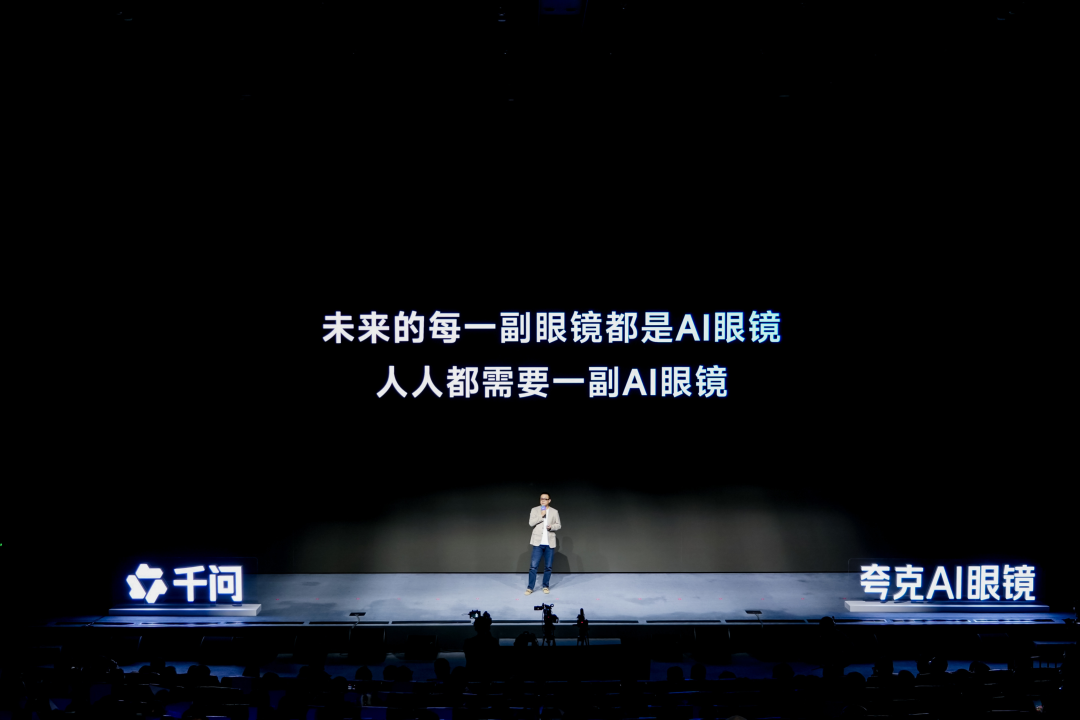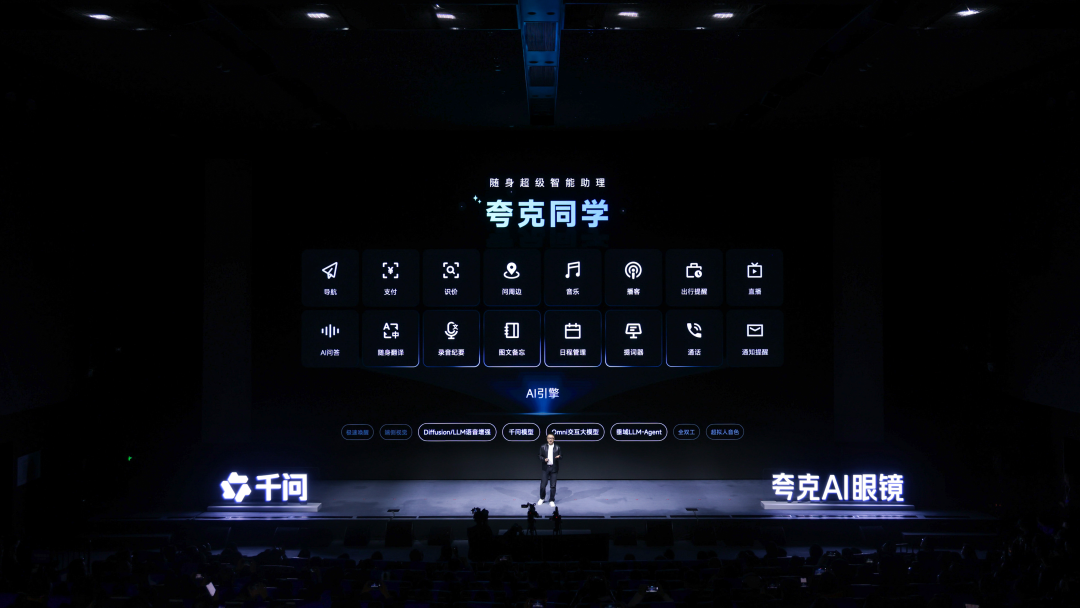Quark Brings QianWen to Life in Hardware Form
![]() 11/28 2025
11/28 2025
![]() 380
380

Written by | Wu Xianzhi, Wen Yehao
Edited by | Wang Pan, Pan
On November 27, Quark unveiled two series of AI glasses, comprising six models, in Beijing.
The flagship offering is the Quark AI Glasses S1, starting at 3,799 yuan. The other series, the lightweight Quark AI Glasses G1, is available in a sunglasses variant, with prices beginning at 1,899 yuan.
"The core strength of an AI assistant lies in its intelligence and efficiency in accomplishing tasks... Users need an AI that is accessible anytime, anywhere," Wu Jia, Vice President of Alibaba Group and President of the Smart Information Business Group, stated at the launch event. His remarks set the tone for the Quark AI Glasses launch and indicated that, from a business strategy perspective, the event was part of a broader initiative.
Wu Jia's message was unequivocal: a mobile AI assistant alone cannot fully realize AI's potential for consumers. Instead, a hardware product that seamlessly integrates with users' daily lives is essential. Compared to smartphones, AI glasses provide a more direct and intuitive interface for input and output.
In conjunction with Alibaba's QianWen public beta test ten days earlier, the Quark AI Glasses launch represented a continuation of Alibaba's broader AI-to-consumer strategy. This was evident from the event's setup, where prominent logos for QianWen and Quark AI Glasses flanked the main stage.

Individually, neither AI assistants nor AI glasses have yet achieved their "iPhone moment." Whether the combination of AI assistants and AI glasses will prove viable remains uncertain. For now, no one can definitively predict how super apps will integrate with the physical world.
From "Hardware Form" to "Essence"
For AI glasses, the hardware is undoubtedly the "physical form." Without robust physical capabilities, even the most sophisticated "essence" or software is meaningless.
The Quark AI Glasses feature a dual-chip architecture, combining Qualcomm's AR1 and BES2800 from BesTV, with a dual-eye diffractive waveguide display offering up to approximately 4,000 nits of brightness. The glasses support adjustable image distance and a dual-battery system, with a design optimized for Asian facial features.
From a hardware standpoint, this generation of Quark AI Glasses does not follow the trend of some industry prototypes that "show off" cutting-edge tech but instead opts for more mature, reliable solutions.
Take display technology as an example. The Quark AI Glasses utilize JBD's "Hummingbird Mini II" MicroLED monochrome light engine.
This solution has been previously employed in products like the StarV Air2 smart glasses by Starry Meizu, the INMO GO2 simultaneous interpretation glasses by INMO Technology, and Rokid Glasses, establishing a stable industrial foundation in terms of brightness, power consumption, and yield.
In contrast, industry pioneers like TCL's Thunderbird have shifted toward full-color waveguide solutions that support video viewing. However, this comes with a significant increase in cost and retail pricing. Alibaba appears more focused on ensuring its products can smoothly penetrate the consumer market rather than chasing technological hype.
On the other hand, as a latecomer, the Quark AI Glasses have addressed issues found in earlier products.
For instance, waveguide AR glasses previously suffered from vergence-accommodation conflict, where the focal plane did not align with the real world, causing eye strain and dizziness over prolonged use. The Quark AI Glasses mitigate this with adjustable image distance, allowing users to select the optimal display distance based on the scenario.
As for common issues in waveguide technology, such as rainbow artifacts and obstructed field of view, the Quark AI Glasses intentionally reduce the grating area to minimize AR's "distraction" from the real world.
Overall, compared to competitors who are overly enthusiastic about "selling the future," the hardware approach of the Quark AI Glasses may not be flashy, but it at least ensures their viability as an emerging product category.
Whether AI glasses can ultimately succeed largely depends on their "essence"—the refinement of software and system layers is currently the focal point of this field.
From a software perspective, the differentiation among current AR glasses manufacturers is visually apparent.
The Quark AI Glasses are built on Alibaba's ecosystem, integrating services like AutoNavi Maps, Alipay, Taobao, and Fliggy, while also connecting to NetEase Cloud Music and QQ Music. This aims to create a closed-loop service ecosystem for the AI glasses.
From AI and translation to navigation, QR code payments, and price comparisons, this comprehensive set of Alibaba-backed capabilities ensures a complete service and application chain. However, for now, this "internal integration" seems to somewhat limit the Quark AI Glasses.
Take the Thunderbird X3 Pro as an example. Its strategy is more "inclusive"—on one hand, it integrates Alibaba's Tongyi QianWen while also supporting Doubao. For maps, it partners with AutoNavi Maps to offer visual navigation, emphasizing broad coverage through multi-application collaboration. Rokid Glasses are even more open in the AI space, adopting a "we want them all" approach with large models.

In contrast, the Quark AI Glasses are clearly more "inward-focused"—unlike other players who emphasize multi-model and multi-application integration, the Quark AI Glasses, as Alibaba's frontline for AI consumer-end efforts, currently exhibit lower openness to external ecosystems, even failing to fully adapt to basic social entry points like WeChat.
These differing strategies stem more from inherent strengths and weaknesses, with no absolute right or wrong.
Most domestic AR manufacturers are primarily hardware-focused and lack the ability to fill application ecosystem gaps, making openness inevitable. Alibaba, as an internet giant with a robust application ecosystem, is naturally unwilling to see its products benefit competitors.
This may explain why NetEase Cloud Music and QQ Music are among the few external applications currently integrated into the Quark AI Glasses—after Xiami Music's exit, online music represents an unavoidable ecosystem gap within Alibaba's framework and is a significant demand for smart glasses.
While the possibility of more external applications joining the Quark AI Glasses ecosystem cannot be ruled out, the differing perspectives and approaches have largely determined its strategy of "doing more with less." In this context, Alibaba's heavy investment in AI may serve as a "game-changer."
Thus, the ongoing battle is not only a test for the Quark AI Glasses but also a direct examination of Alibaba's AI capabilities.
Why Quark?
The hardware capabilities and hot-swappable power design of the Quark AI Glasses theoretically allow them to cover most daily life scenarios. To borrow a phrase from NIO's William Li, "No matter how fast charging gets, battery swapping is faster."
Given that these AI glasses are currently Alibaba's only wearable hardware product in its AI-to-consumer strategy, battery life is a critically important metric. Only long battery life can ensure seamless user interaction across various scenarios.
It is worth mentioning that the Quark AI Glasses also hint at a transformation of search entry points. The glasses' interaction methods include voice, vision, and buttons, with the onboard AI assistant, "Quark Classmate," integrating the AI capabilities of QianWen and Quark.
In fact, Quark Classmate shares similarities with competitors' super assistants like Xiaodu, both leveraging AI assistants and hardware to explore new interactions in the AI era through multimodal capabilities.
Traditional search, whether on PCs or mobile devices, relies on keyboard/mouse or touch input combined with keyword retrieval. The breakthrough of multimodal technology not only adds voice and visual inputs but also diversifies interaction behaviors from singular to multifaceted.
From this perspective, Quark—Alibaba's traditional search entry point—launching AI glasses to seek new entry points in the AI era is not incongruous.
In fact, the product philosophy of the Quark AI Glasses highly aligns with Quark's mobile-era logic: using search-as-a-service to enhance user engagement and frequency by aggregating various high-frequency, essential tools.
For example, the dual-layer architecture of a search bar and a smart panel reduces homepage information density by 67% while dynamically loading high-frequency needs through smart cards. The smart panel integrates tools like AI writing, scanning, Quark PPT, and translation.
This shift and integration from search to tools have proven effective for Quark amid the recent surge of AI products. Initiatives like the "College Enrollment" Agent for students, photo-based search for homework help, and image search in Quark NetDisk's file management have established a "problem-solving" mindset among consumer-end users.
"The greatest imagination for AI lies not in smartphone screens but in transforming the physical world," Alibaba's Wu Yongming stated at the 2024 Cloud Town Conference when discussing AI. This remark, to some extent, served as a wake-up call for Quark. Even with search capabilities and a wealth of high-frequency, essential tools, Quark had not truly extended its reach into the physical world in the AI era, thus lacking strong entry-point attributes.
Perhaps for this reason, Alibaba entrusted Quark with the soft-hardware integration of its AI-to-consumer strategy.
Another factor is that the transition from software-based AI assistants to hardware-based AI glasses positions Quark's strength—its long-cultivated "tool mindset"—more prominently than other products. From ad-free search in the search era to tools like NetDisk and the Gaokao Assistant, and now to an AI all-in-one assistant, the underlying theme has been the continuous enhancement of practical value. Alibaba aims to replicate this search-tool-assistant integration onto AI glasses to facilitate user habit migration.
The Quark AI Glasses currently offer 16 high-frequency functions, including navigation, payments, price identification, music, Q&A, and calls.

However, it must be acknowledged that reusing Quark's software strengths to transform AI glasses into a super entry point in the AI era requires ongoing validation.
The monochrome display solution means entertainment is not the primary focus of Quark's two AI glasses models, leading to varying user experiences across scenarios. Quark has showcased usage in commuting, walking, and shopping but faces competition from other products or combinations in other contexts. For instance, entertainment—the most time-consuming scenario—requires a full-color display rather than a monochrome one.
Additionally, as Quark's first attempt at soft-hardware integration, covering more products presents further challenges. For example, in office scenarios, integrating AI glasses with computers, headphones, printers, and other devices remains unexplored.
Standing Before the Next Entry Point Once Again
Alibaba, with its powerful AI capabilities, could have easily profited as a "shovel seller" in the AI glasses gold rush without directly entering the hardware market. However, for internet giants, hardware entry points represent an almost instinctive obsession.
From a longer timeline, since the widespread adoption of smartphones, the consumer electronics industry has continuously sought the next entry point. Smart glasses, or more broadly, XR, hold this promise—like a star visible at night yet always out of reach.
Early attempts focused on audio-visual experiences, followed by a charge led by Half-Life: Alyx and hardware manufacturers. During the metaverse hype, players collectively bet big again. Nearly every wave of participants entered with different logics and hardware forms, confident that this time they would succeed, only to be pulled back by reality, failing to cross the mass-market threshold.
The reason players have repeatedly become "cannon fodder" is not due to insufficient technological prowess but because the broader consumer market lacks urgent demand. In hardware, a new device only qualifies as an entry point when it creates a higher-frequency or more irreplaceable behavioral scenario than existing devices.
The AI boom has reignited hope among players to construct such an entry point. While still immature and highly experimental, AI now shows, for the first time, a pathway to large-scale user adoption, unlike past narratives centered around geeks and enthusiasts.
Thus, Alibaba and other AI glasses manufacturers today are not merely competing for existing fruits but exploring and laying the groundwork for an uncertain future, allowing the next entry point to potentially take a half-step from "ideal" to "reality," even if it remains far from the "final destination."
Ultimately, whether the gap can be bridged depends on more than just a few applications or hardware products.






